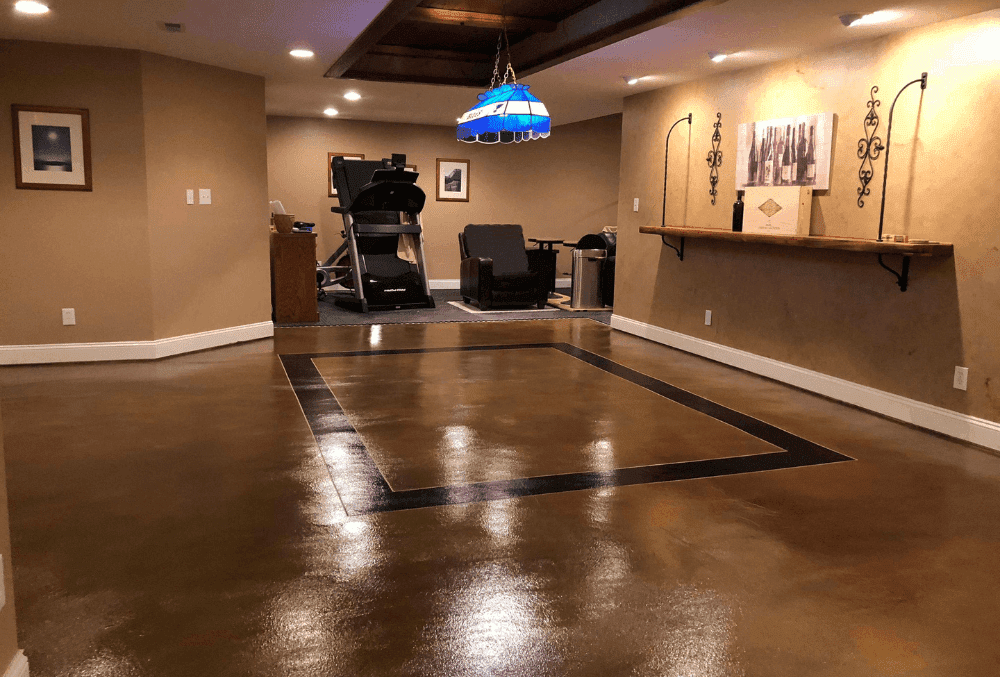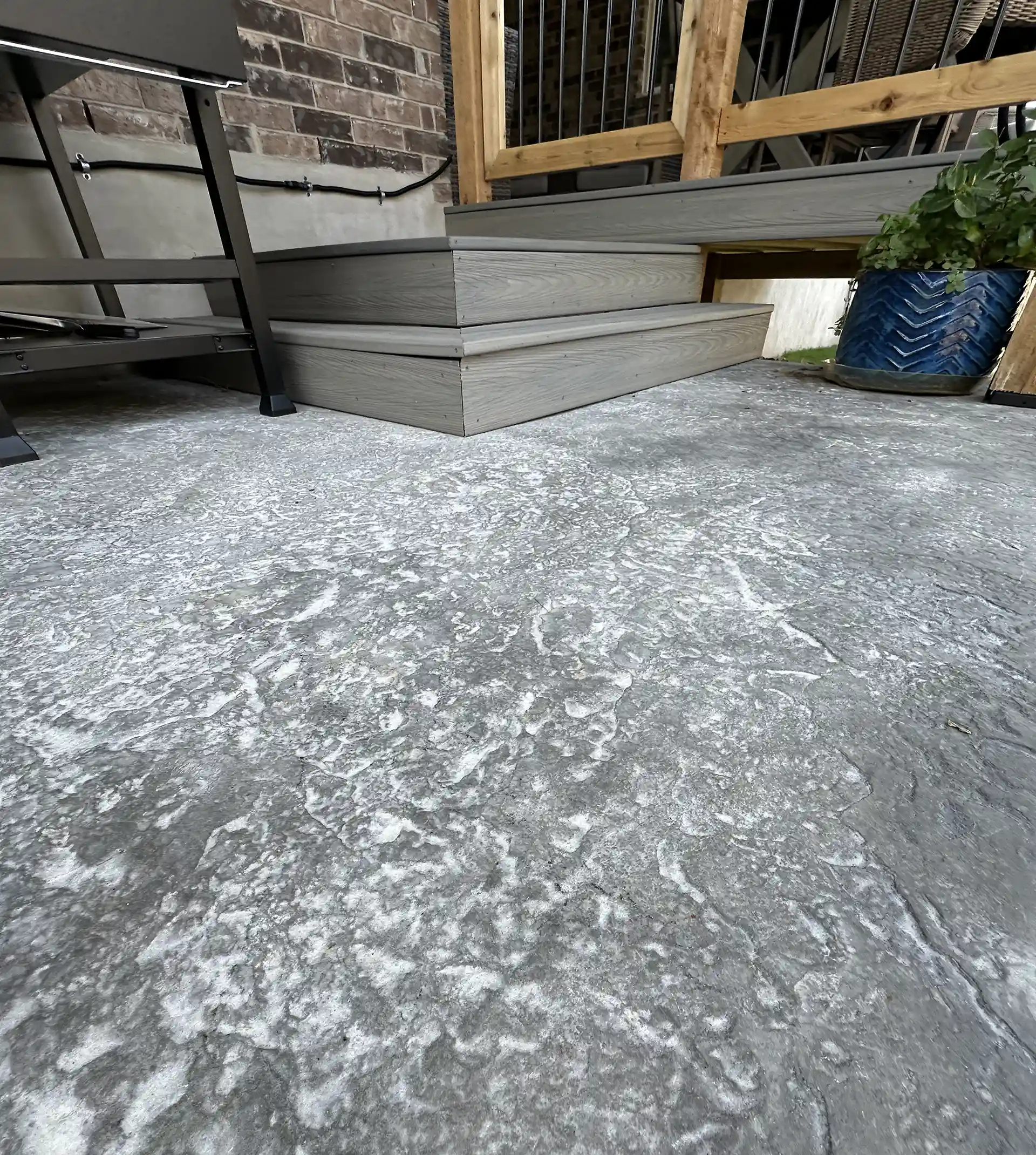Step-by-step process of water-based staining with stained concrete
Comprehending the Array of Services Offered in Floor Covering: Highlighting Stained Concrete Techniques
Stained concrete has become an engaging flooring option for numerous spaces. Its flexibility lies in the choice between acid and water-based spots, each offering distinct appearances. Appropriate prep work and ongoing maintenance are vital to ensure its durability and look. As the need for ingenious floor covering remedies grows, comprehending the nuances of stained concrete strategies might open up new possibilities for both household and commercial atmospheres. What distinct advantages might this flooring alternative bring to a task?
The Basics of Stained Concrete
Stained concrete functions as a versatile flooring alternative that combines durability with visual allure. This flooring technique involves applying a particularly formulated stain to the concrete surface, which permeates and alters the shade of the material. The process not just boosts the appearances of concrete but additionally uses the advantage of securing it from damage. Stained concrete can achieve a wide variety of looks, from natural tones to vibrant hues, making it appropriate for different layout motifs.
Appropriate preparation of the concrete surface is crucial for perfect results. This may include cleaning, grinding, or engraving to ensure the stain adheres properly. On top of that, the application process generally entails making use of devices such as sprayers or brushes to attain consistent protection. After staining, a sealer is commonly put on boost resilience and preserve the vibrancy of the shade. Eventually, discolored concrete supplies an eye-catching and resilient floor covering option for household and commercial areas alike.
Kinds of Stains: Acid vs. Water-Based

On the other hand, water-based spots use a wider series of colors and are easier to use. They do not respond chemically with concrete however instead offer a surface area tint - Austin stained concrete company. Water-based spots are low in unpredictable organic substances (VOCs), making them much more environmentally pleasant and ideal for interior jobs. While they might not offer the very same depth of shade as acid stains, their versatility and simplicity of usage make them appealing for different applications. Inevitably, the selection relies on the task's needs, preferred aesthetic appeals, and area
Methods for Staining Concrete
The techniques for discoloring concrete differ substantially between acid and water-based techniques. Acid staining includes a chemical response that creates special, variegated colors, while water-based spots offer a broader palette and much easier application. Comprehending these procedures is essential for accomplishing the preferred aesthetic in concrete flooring.
Acid Staining Refine
Acid staining uses a vibrant means to boost the aesthetic charm of concrete surfaces. This process includes using a mixture of water, hydrochloric acid, and pigments to the concrete, which responds chemically to create lively, clear colors. Initially, the concrete surface has to be thoroughly cleansed and prepped to assure suitable adhesion. Once applied, the acid stain permeates the concrete, developing distinct marbled results as it responds with the lime in the concrete. After the preferred shade establishes, the surface area is neutralized and rinsed to stop the reaction. A sealer is used to safeguard the finish and enhance durability. Acid staining not just transforms the appearance of concrete yet also gives a durable option for attractive floor covering.
Water-Based Staining Benefits
Exactly how can water-based staining boost the aesthetic and useful high qualities of concrete surfaces? Water-based spots provide a versatile option for enhancing concrete, giving lively shade options while guaranteeing ecological safety and security. Unlike acid spots, water-based choices penetrate the surface area, enabling also color distribution and a variety of surfaces, from matte to shiny. Furthermore, they are reduced in unstable natural substances (VOCs), making them less dangerous to interior air high quality. Their fast drying time promotes quicker project conclusion, while their resistance to fading guarantees resilient beauty. Water-based stains can also boost the concrete's durability and resistance to stains, making them an ideal selection for both household and commercial applications. Eventually, they offer a lasting, eye-catching option for numerous concrete surface areas.
Design Possibilities With Stained Concrete
Stained concrete offers a series of style possibilities that can boost any type of area. Methods such as shade variation, numerous surface ending up alternatives, and personalized layout patterns permit special and personalized floor covering services. These elements not just boost appearances but also add to the total performance of the concrete surface area.
Shade Variation Methods
While checking out the layout opportunities of discolored concrete, shade variation methods play a crucial duty in enhancing both aesthetic charm and capability. These methods enable the development of special patterns and impacts that can change a simple concrete surface area into an aesthetically striking aspect of a room. Alternatives such as acid staining, which responds chemically with the concrete, create rich, transparent hues that resemble natural stone. Water-based discolorations use a more comprehensive shade scheme and enable more article source control in design. Layering various discolorations can create depth and dimension, giving a personalized look. By integrating color variation methods, designers can achieve diverse styles, from rustic to contemporary, ensuring that stained concrete fits effortlessly into any type of design scheme.
Surface Area Finishing Options
The expedition of color variation strategies establishes the phase for thinking about surface ending up options, which greatly impact the overall look and capability of stained concrete. Numerous finishes can boost the Homepage visual charm and sturdiness of the surface. Usual options include matte, satin, and shiny finishes, each providing an unique aesthetic result. Matte surfaces provide a refined, underrated style, while satin finishes strike an equilibrium in between shine and practicality, making them prominent for domestic and commercial spaces. Shiny coatings, on the various other hand, create a high-shine appearance, enhancing color vibrancy and light representation. Furthermore, surface area treatments such as sprucing up or securing even more enhance long life, making these completing options vital factors to consider in making practical and visually enticing tarnished concrete floors.
Personalized Layout Patterns
Exactly how can personalized layout patterns boost the charm of stained concrete? By integrating one-of-a-kind layouts, discolored concrete can transform normal floor covering right into a striking aesthetic declaration. Custom-made patterns, such as geometric shapes, elaborate motifs, or organic designs, permit personalization, making spaces feel customized and welcoming. Clients can select from a range of methods, including saw cuts, patterns, or overlays, to achieve wanted effects. In addition, combining numerous shades with numerous stain methods enhances the depth and measurement of the patterns. These design opportunities not only improve visual appeal yet also enhance the worth of property or commercial rooms. Eventually, custom layout patterns supply an opportunity for creative thinking, establishing tarnished concrete aside from standard flooring options.
Preparing Your Concrete Surface Area
Appropriate prep work of the concrete surface area is crucial for achieving a successful tarnished coating. This process begins with extensive cleansing to eliminate dust, oil, and any kind of other pollutants. A pressure washing machine or a floor scrubber can effectively get rid of these materials, ensuring a tidy slate for staining. After cleansing, it is vital to fix any kind of fractures or imperfections in the concrete. This can be completed using a concrete patching substance, which should be permitted to cure completely prior to proceeding.
Once the surface area is tidy and fixed, grinding or fining sand may be needed to create a smooth, also texture. This step boosts the concrete's capacity to take in the stain uniformly. Lastly, a concrete etcher can be applied to open the pores of the surface, permitting far better bond of the stain (Austin stained concrete company). By complying with these preparation steps, the resulting discolored concrete will certainly show a more dynamic and long lasting coating
Upkeep and Take Care Of Stained Concrete
Preserving tarnished concrete is essential for maintaining its look and durability after the preliminary prep work and application of stain. Normal cleaning is essential; sweeping or vacuuming to get rid of dirt and particles avoids scratches and monotony. For much deeper cleaning, a mild pH-neutral detergent mixed with water can be utilized, followed by detailed rinsing to stay clear of residue accumulation.
Sealing discolored concrete is another vital maintenance step, as it shields the surface area from discolorations and moisture. Depending upon the sealer kind, reapplication might be essential each to 3 years. In addition, preventing severe chemicals and unpleasant tools helps maintain the stability of the stain.
For outside stained concrete, it is a good idea to clear snow or ice immediately to stop damages from freeze-thaw cycles. Overall, read this article regular care guarantees that discolored concrete preserves its vibrant color and structural stability in time, making it a durable flooring option.

Price Factors To Consider for Stained Concrete Floor Covering
When evaluating the cost of tarnished concrete floor covering, potential home owners often ask yourself regarding the numerous factors that influence rates. Key factors to consider consist of the dimension of the area to be covered, the complexity of the layout, and the sort of stain utilized. Basic staining techniques have a tendency to be more budget friendly, while detailed patterns or numerous colors can substantially boost costs.

Geographical place is another factor, as prices can vary widely from one region to an additional. Ongoing maintenance expenses must be factored in, as sealants and safety finishings may be needed over time to preserve the visual and sturdiness of the stained concrete.
Regularly Asked Inquiries
Can Stained Concrete Be Applied Over Existing Floor Covering?
The concern of whether stained concrete can be applied over existing floor covering is frequently asked. Normally, it is feasible, provided the underlying surface area is clean, stable, and suitable for correct bond of the discolored concrete.
For how long Does the Staining Process Take?
The staining procedure commonly takes a few hours to a full day, depending upon the size of the area and the intricacy of the design. Healing may require extra time prior to the surface is completely usable.
Is Stained Concrete Suitable for Outdoor Usage?
Stained concrete is undoubtedly ideal for outdoor use, as it endures various climate condition. Its toughness and visual allure make it a prominent option for patio areas, walkways, and driveways, enhancing both performance and aesthetic interest.
Can I Adjustment the Shade of Stained Concrete Later On?
The capacity to change the color of tarnished concrete later on relies on various variables, consisting of the initial stain type and surface area prep work. Consulting a professional can give guidance on possible choices and end results for shade modification.
Are There Eco-Friendly Options for Stained Concrete?
The inquiry about environment-friendly options for stained concrete discloses an expanding rate of interest in lasting structure techniques. Lots of firms now use low-VOC stains and ecologically friendly sealers, ensuring aesthetic allure while minimizing environmental effect.